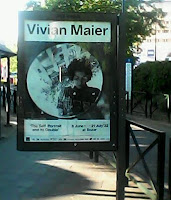It’s quite a paradox, especially for ponderous art lovers: in existential stress situations one apparently does not turn to those art works with the heaviest philosophical credentials or the highest emotional pitch. One rather seeks refuge in pure aesthetic attention: following a beautiful bold brush stroke (1) , listening intently to a subtly modulating melody (2), savouring the changing luminosities of the sky.
So, for
instance, on that early morning end of January, after a sleepless night
worrying about the diagnosis I’d just received (3), I could not eat, I could
not read, nor could I find solace in Bellini’s heart-felt Gethsemane or in any other
pathos-filled paintings. But leafing
distractedly through my art books, my
trembling finally did recede, my anxiety did get quelled by the soothing sight of an elegant annunciation angel (4).
One can
observe the same phenomenon, when, with age, a certain tiredness (5) and the inescapable experience of the frailty
of life (6) seem to engender an
increasing need for sheer beauty & harmony. A craving for disinterested
aesthetics as a source of relief from the perils of the world, from one’s own
anxieties (7), offering moments of reprieve from chaos and discord (8).
In previous
eras, a sense for metaphysics and a belief in transcendence would have given
legitimation to this longing for aesthetic bliss – it would have been seen as
serious proof of the immanent congruence between cosmic harmony and the human
soul (9).
By
contrast, in our (post) modern times aesthetics and harmony have often been discredited as
being amoral, apolitical. And since the romantic era, pure absolute musical harmonies
have become suspect for their alleged lack of individual emotional
expressiveness. In our age, we rather
prone political action and technological solutions to put things right, we
rather recommend the sharing and expressing of raw emotions without overly
formal complexities.
But ah, it
is something (10) to be able to focus
only on perceiving, on making sense, on discerning harmonies and significations
(11). And it is something to believe that this intense aesthetic attention
can bring us closer to timeless sublime principles of beauty and signification,
surpassing our own frail petty lives, adumbrating a possible human dignity
shared across the ages.
Douze
Petites Notes … (12)
(1) Eg Tiepolo rather than Rembrandt,
(2) Eg Mozart rather than Beethoven
(3) A scary medical diagnosis, with uncertain outcome at the time. But effectively treated now, so I can look back with relief to the whole episode (and blog-readers need not to worry)
(4) Giovanni Bellini, St Vincent Ferrer Polyptych - Detail of an annunciation angel
(5) a growing realisation of how the world is, how life is – and our (or at least, my) utter inadequacy & powerlessness
(6) as most of us must experience one day: the death of a parent, and prior to that - so shocking, so painful - their decay.
(7) A Nietzsche-quote, stumbled upon in an old notebook of mine, well worth to be reproduced again here digitally: « Ma mélancolie peut se reposer dans les cachettes et dans les abîmes de la perfection, c’est pour cela que j’ai besoin de musique »
(8) This flight into the safe Haven of Harmony, goes back a long way: “The Pythagoreans […] cleansed their minds of the noises and perturbations to which they had been exposed during the day by certain odes and hymns, which produced tranquil sleep and few, but good dreams.” (p32 Jamie James: “The Music of the Spheres” see below)
(9) As elaborated in this wonderful book by Jamie James: “The Music of the Spheres – Music, Science and the natural Order of the Universe” .
(10) “something”? something fervently to look forward to, each and every day: dwelling in beauty in the early still hours of the day, coming home to music after all the sound & fury of a worldly day
(11) Some key elements in the exercise of our aesthetic-cognitive faculties; as noted by Alpers & Baxandall in their study on Tiepolo (“Tiepolo et l’intelligence picturale”) : « […] Produire du sens, […] Chercher de la lumière […] Le travail de déchiffrement présente un pur plaisir »
(12) Also the title of the first section of Andre Manoukian’s effortlessly swinging & learned book on music (“Sur les routes de la musique”). And so we make it to twelve silent notes – hurled into the world wide web, perhaps to be read only by some voraciously learning chatbot.










